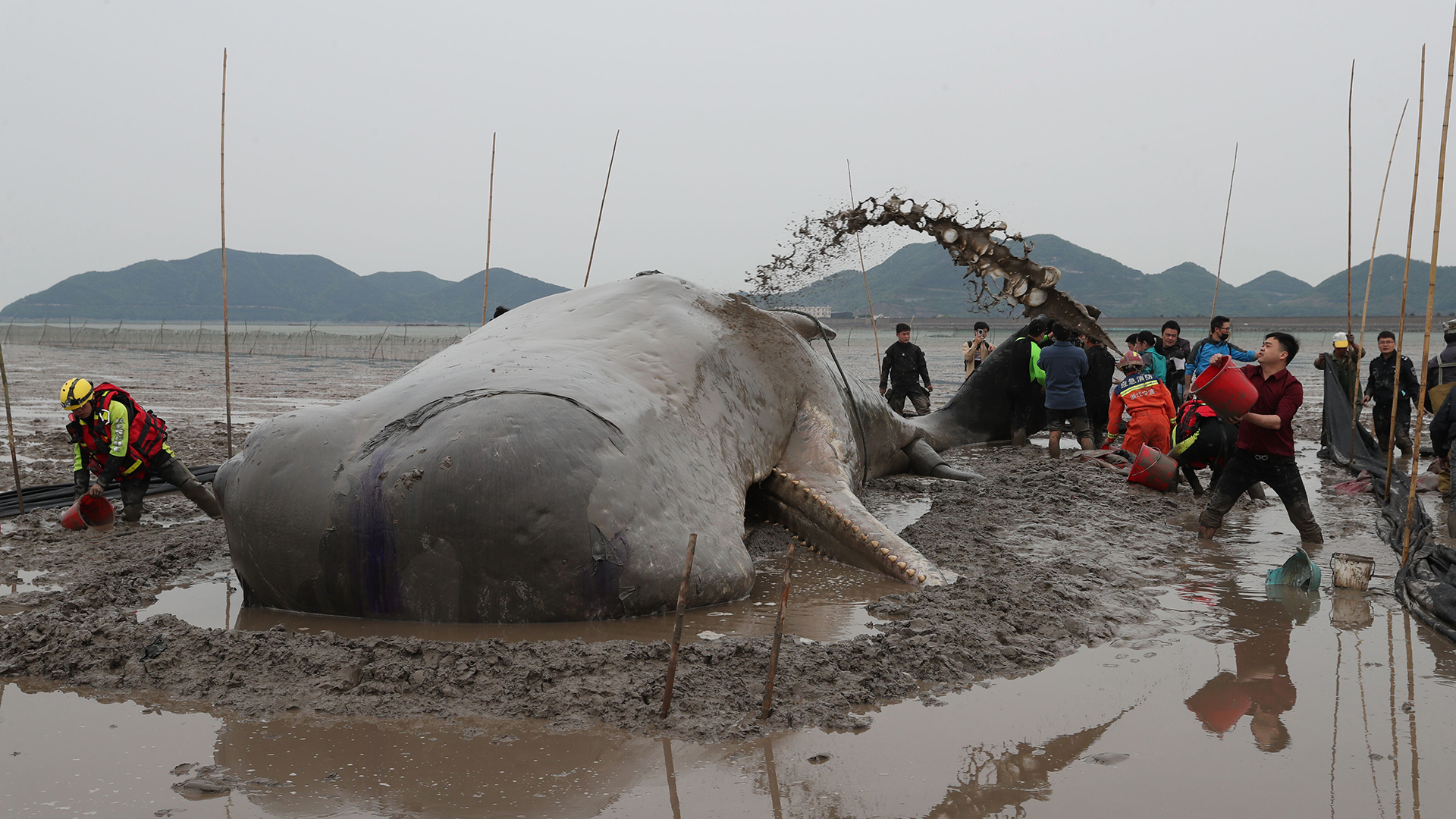Enormous beached sperm whale rescued in China. Will it survive?
Rescuers took 20 hours to get the distressed whale back into the sea.

A huge sperm whale stranded in the shallows near Ningbo, China, was towed back to sea last week after a strenuous 20-hour rescue.
The whale's ultimate fate, however, will probably never be known. Strandings are difficult on sperm whales (Physeter macrocephalus), and animals don't always survive even if they are rescued, said Bruce Mate, professor emeritus in fisheries, wildlife and conservation and the past director of the Marine Mammal Institute at Oregon State University's Hatfield Marine Science Center.
"Good on them for making a noble effort in trying to get this animal back to sea, but the odds are quite difficult," Mate told Live Science.
Rescue effort
The sperm whale was floundering in the shallows when it was spotted by fishers April 19, according to U.K. news outlet Sky News. Video from China's state news channel showed the animal flapping its tail, unable to move its body.
As the tide went out, the 62-foot-long (19 meters) whale was left lying on its side on a mudflat, in danger of suffocating under its own weight or dying of dehydration. Heat is among the greatest dangers to a stranded sperm whale, Mate said. These whales are deep-sea hunters that routinely hunt for prey in the frigid waters more than a mile (1.6 kilometers) below the ocean surface. The air temperature in Ningbo peaked at about 66 degrees Fahrenheit (19 degrees Celsius) on April 19. Even though that isn't hot for a human, temperature regulation is different for sperm whales.
Related: Deep blue sea: Winning underwater photographs
"Blubber keeps internal body heat in and leads to overheating if the whale cannot get rid of the heat another way," Mate said. "Getting rid of body heat is done [in] a variety of ways, including water contact with the skin, especially at thin structures, like flukes and flippers, and very vascular areas, like the tongue. It is not possible for the whale to do this when it is out of the water."
Get the world’s most fascinating discoveries delivered straight to your inbox.
Local authorities attempted a rescue with five boats, according to the South China Morning Post, but the whale was too large to move. Volunteers used buckets to douse the whale with water as they waited for the tide to rise.

Finally, at 10 p.m. local time, the water rose enough for a tugboat to pull the whale deeper into the ocean, according to Metro U.K. At 5:30 a.m. local time on April 20, authorities were able to cut the ropes towing the whale, and the animal began swimming independently.
Stranding survival
Given its size, the whale was probably an adult male, Mate said. That was likely a blessing: Sperm whale females and juveniles live in pods. When a female, calf or young male in a pod strands, the rest of the pod may follow it, drawn by the stranded whale's distress cries. The result, Mate said, is often mass death. In the early 1970s, he responded to a stranding of 43 sperm whales along the Oregon coast. Not a single animal survived. Adult males, in contrast, live alone. That means the adult male in Ningbo also stranded alone, limiting the damage to the population as a whole.
Strandings can occur for different reasons. In some cases, there is something wrong with the whale that affects its ability to survive in the long run, Mate said. Not long after the 1970s mass stranding in Oregon, another calf was found in the same area, floundering in the shallows. More than two dozen members of the whale's pod hovered just offshore, seemingly poised to follow the distressed calf. Mate and other biologists and volunteers managed to get the calf out of the water so it could no longer communicate with its pod. To the researcher's relief, the other whales turned away and swam back out the sea.
The calf, meanwhile, was taken to an oceanarium for rehabilitation. There, it died within days. A necropsy revealed that the calf had a twisted gut, a condition that occurs when the gut literally twists in on itself, constricting blood supply and causing shock. (In pets and farm animals, this condition is often known as "bloat," and it is a medical emergency.) It was an example of a stranded animal that was unsavable, Mate said, but human intervention still saved the rest of the pod from dying unnecessarily.
Even when a healthy animal gets stranded, the stranding itself may damage the organs beyond repair. The sperm whale circulatory system isn't designed to work on land, Mate said. A stranded animal's tissues may start deteriorating, and the longer the animal is out of the water, the more damage it may sustain.
"What happens for these animals is, their individual organs start the process of dying, but the whole animal doesn't die until days later," Mate said.
Animals may also simply get lost or make a mistake, leading to an irrevocable stranding. In the course of less than two months in 2016, 30 sperm whales were beached in the North Sea. Researchers saw no evidence of disease or injury that could have caused the strandings; rather, the whales likely became trapped as the tide receded while they were hunting for food, according to a 2018 study in the journal PLOS One.
In another stranding, in Scotland in 2019, a necropsy revealed a 220-pound (100 kilograms) ball of trash in the stomach of a dead sperm whale. It was unclear whether the trash ball was related to the whale's stranding and eventual death. Scientists found that the animal was not malnourished, despite the "horrific" amount of trash.
Because sperm whales travel so far and dive so deep, it's unlikely that humans will ever hear from the stranded Ningbo whale again, unless it does die and the tides and currents happen to carry it back to shore. Even if the animal dies at sea, though, it will nurture new life. Dead whales eventually land on the ocean bottom — a phenomenon called "whale fall." There, they become a bonanza for strange creatures, such as hagfish and bone-eating worms.
"They'll be a source of nutrients that continues to give to that community for two to five years," Mate said.
Originally published on Live Science.

Stephanie Pappas is a contributing writer for Live Science, covering topics ranging from geoscience to archaeology to the human brain and behavior. She was previously a senior writer for Live Science but is now a freelancer based in Denver, Colorado, and regularly contributes to Scientific American and The Monitor, the monthly magazine of the American Psychological Association. Stephanie received a bachelor's degree in psychology from the University of South Carolina and a graduate certificate in science communication from the University of California, Santa Cruz.


